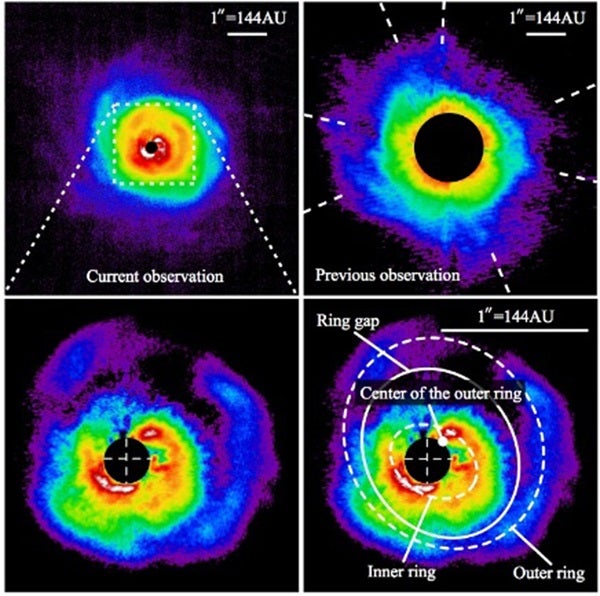One of the images is of the disk of the very young star AB Aur in the constellation Auriga. The star is only about 1 million years old and is surrounded by its protoplanetary disk, a structure of gas and dust from which planets are likely to form. The image displays high spatial resolution as well as high contrast within the disk near its central star. It reveals, for the first time, the fine structures of a disk orbiting closer to its star than Neptune’s distance from the Sun in our solar system. AB Aur’s disk has double rings that are tilted from the equatorial plane, a void of material between the rings, and a center that does not coincide with the position of the star. These irregularities suggest that at least one giant planet is affecting the features of the disk.
The other image from the project is that of another young star, LkCa 15, which is several million years old. Although previous works speculated that there was a gap in its disk, this is the first direct imaging of a central gap in the disk. The lack of material in the vicinity of the central star implies that a giant planet is sweeping up the disk’s leftover materials that the central star did not swallow.
Overall, these first two direct images of the detailed structure of the protoplanetary disks provide strong evidence for planet formation within a system on the scale of our solar system. The influence of heavy planets is likely to have produced the irregular features of the disks. The SEEDS project will continue for 5 years, allowing astronomers to search the universe for exoplanets and their protoplanetary disks, in an ongoing quest to decipher how planetary systems form. Recent and future findings from the project may eventually contribute to our understanding of how earthlike habitable zones develop.
One of the images is of the disk of the very young star AB Aur in the constellation Auriga. The star is only about 1 million years old and is surrounded by its protoplanetary disk, a structure of gas and dust from which planets are likely to form. The image displays high spatial resolution as well as high contrast within the disk near its central star. It reveals, for the first time, the fine structures of a disk orbiting closer to its star than Neptune’s distance from the Sun in our solar system. AB Aur’s disk has double rings that are tilted from the equatorial plane, a void of material between the rings, and a center that does not coincide with the position of the star. These irregularities suggest that at least one giant planet is affecting the features of the disk.
The other image from the project is that of another young star, LkCa 15, which is several million years old. Although previous works speculated that there was a gap in its disk, this is the first direct imaging of a central gap in the disk. The lack of material in the vicinity of the central star implies that a giant planet is sweeping up the disk’s leftover materials that the central star did not swallow.
Overall, these first two direct images of the detailed structure of the protoplanetary disks provide strong evidence for planet formation within a system on the scale of our solar system. The influence of heavy planets is likely to have produced the irregular features of the disks. The SEEDS project will continue for 5 years, allowing astronomers to search the universe for exoplanets and their protoplanetary disks, in an ongoing quest to decipher how planetary systems form. Recent and future findings from the project may eventually contribute to our understanding of how earthlike habitable zones develop.










